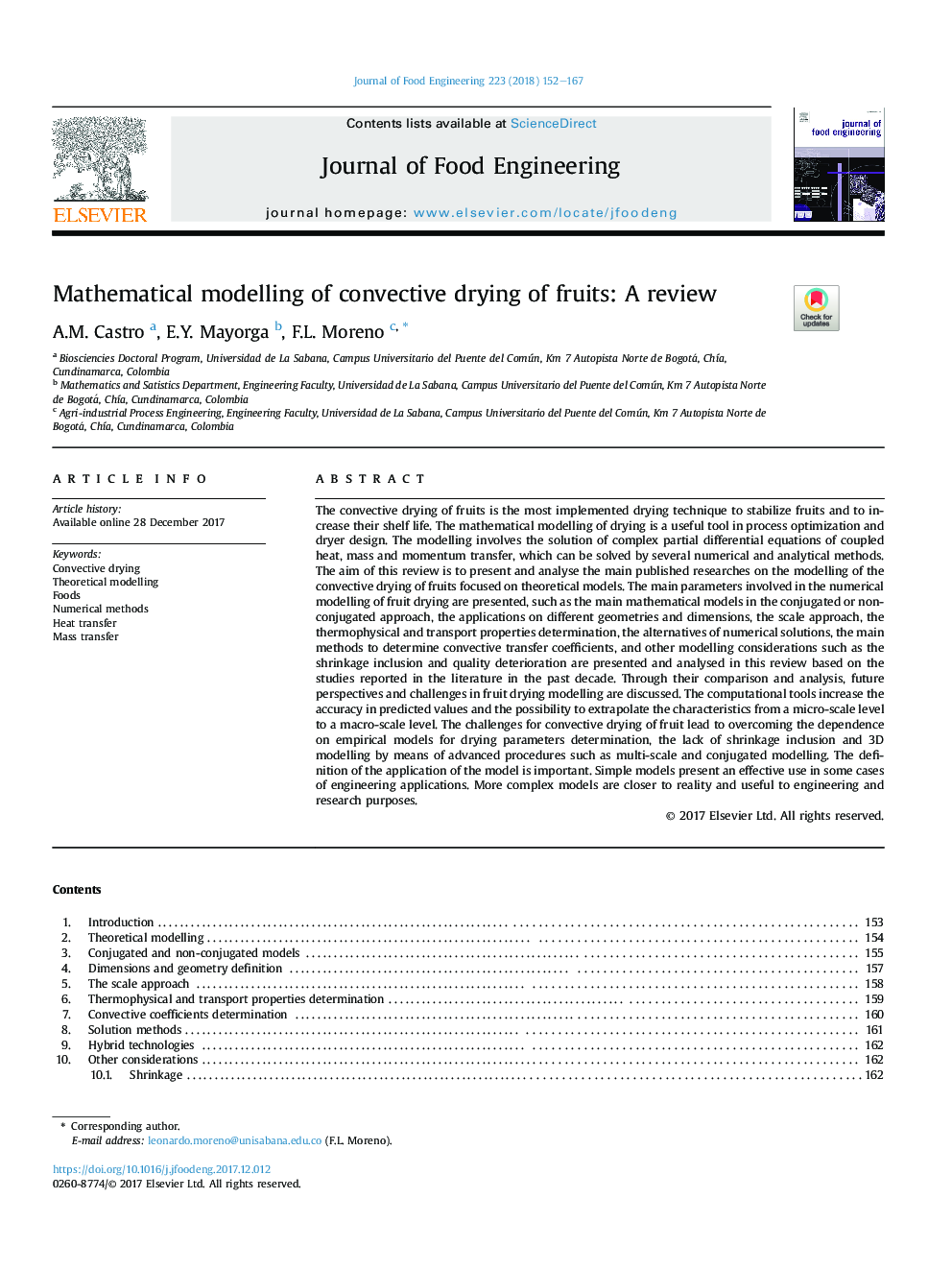| کد مقاله | کد نشریه | سال انتشار | مقاله انگلیسی | نسخه تمام متن |
|---|---|---|---|---|
| 6664746 | 1427078 | 2018 | 16 صفحه PDF | دانلود رایگان |
عنوان انگلیسی مقاله ISI
Mathematical modelling of convective drying of fruits: A review
ترجمه فارسی عنوان
مدل سازی ریاضی خشک کن کنی میوه ها: یک بررسی
دانلود مقاله + سفارش ترجمه
دانلود مقاله ISI انگلیسی
رایگان برای ایرانیان
کلمات کلیدی
خشک شدن هم انعطاف پذیر، مدل سازی نظری، خوراکی ها، روشهای عددی، انتقال گرما، جابجایی عظیم،
ترجمه چکیده
خشک کردن کامل از میوه ها، روشی است که به طور کامل برای خشک کردن میوه ها تثبیت شده و عمر آن را افزایش می دهد. مدل سازی ریاضی خشک کردن یک ابزار مفید در طراحی و بهینه سازی فرآیند است. مدل سازی شامل حل معادلات دیفرانسیل مختلط جزئی از انتقال جرم، جرم و انتقال مولکولی است که می تواند توسط چندین روش عددی و تحلیلی حل شود. هدف از این بررسی ارائه و تحلیل تحقیقات اصلی منتشر شده در مورد مدل سازی خشک کن کنی میوه ها متمرکز بر مدل های نظری است. پارامترهای اصلی در مدل سازی عددی خشک کردن میوه ها، از قبیل مدل های ریاضی اصلی در رویکرد کانجیو یا غیر کنجوج، کاربرد در هندسه ها و ابعاد مختلف، رویکرد مقیاس، تعیین ویژگی های ترموفیزیکی و انتقال، گزینه ها از راه حل های عددی، روش های اصلی برای تعیین ضریب انتقال کنترلی و سایر ملاحظات مدل سازی مانند انقباض و انحراف کیفیت در این بررسی ارائه شده و با استفاده از مطالعات گزارش شده در ادبیات در دهه گذشته مورد تحلیل قرار گرفته است. از طریق مقایسه و تجزیه و تحلیل آنها، چشم انداز های آینده و چالش ها در مدل سازی خشک کردن میوه بحث شده است. ابزار محاسباتی دقت در مقادیر پیش بینی شده را افزایش می دهد و امکان استخراج ویژگی ها از سطح مقیاس کوچک به سطح مقیاس کلان را افزایش می دهد. چالش برای خشک کردن کنتراست میوه منجر به غلبه بر وابستگی به مدل های تجربی برای تعیین پارامترهای خشک شدن، عدم انقباض انقباض و مدل سازی سه بعدی با استفاده از روش های پیشرفته مانند مدل سازی چند بعدی و کنژوگه. تعریف کاربرد این مدل مهم است. مدل های ساده در مواردی از برنامه های کاربردی مهندسی استفاده موثر می کنند. مدل های پیچیده تر به واقعیت نزدیک تر هستند و برای اهداف مهندسی و تحقیقاتی مفید هستند.
موضوعات مرتبط
مهندسی و علوم پایه
مهندسی شیمی
مهندسی شیمی (عمومی)
چکیده انگلیسی
The convective drying of fruits is the most implemented drying technique to stabilize fruits and to increase their shelf life. The mathematical modelling of drying is a useful tool in process optimization and dryer design. The modelling involves the solution of complex partial differential equations of coupled heat, mass and momentum transfer, which can be solved by several numerical and analytical methods. The aim of this review is to present and analyse the main published researches on the modelling of the convective drying of fruits focused on theoretical models. The main parameters involved in the numerical modelling of fruit drying are presented, such as the main mathematical models in the conjugated or non-conjugated approach, the applications on different geometries and dimensions, the scale approach, the thermophysical and transport properties determination, the alternatives of numerical solutions, the main methods to determine convective transfer coefficients, and other modelling considerations such as the shrinkage inclusion and quality deterioration are presented and analysed in this review based on the studies reported in the literature in the past decade. Through their comparison and analysis, future perspectives and challenges in fruit drying modelling are discussed. The computational tools increase the accuracy in predicted values and the possibility to extrapolate the characteristics from a micro-scale level to a macro-scale level. The challenges for convective drying of fruit lead to overcoming the dependence on empirical models for drying parameters determination, the lack of shrinkage inclusion and 3D modelling by means of advanced procedures such as multi-scale and conjugated modelling. The definition of the application of the model is important. Simple models present an effective use in some cases of engineering applications. More complex models are closer to reality and useful to engineering and research purposes.
ناشر
Database: Elsevier - ScienceDirect (ساینس دایرکت)
Journal: Journal of Food Engineering - Volume 223, April 2018, Pages 152-167
Journal: Journal of Food Engineering - Volume 223, April 2018, Pages 152-167
نویسندگان
A.M. Castro, E.Y. Mayorga, F.L. Moreno,
